Moments forts de 2022
Des milliers de jeunes du monde entier, agés de 8 à 18 ans, ont participé à do your :bit 2022. Ils ont trouvé des solutions incroyables et innovantes pour les Global Goals, ils résolu des problèmes auxquels le monde est confronté
Nos juges ont choisi des gagnants dans six régions du monde - Afrique, Asie & Pacifique, Europe, Amérique latine, Moyen-Orient et Amérique du Nord - dans les trois catégories de défi. Découvrez ci-dessous les gagnants, les finalistes et leurs participations.
8-14 ans, solutions micro:bit
Les jeunes ont été mis au défi de concevoir et de réaliser une solution utilisant la micro:bit dans cette catégorie.
Afrique
Tunisie
Jasser, Oussema et Iskander ont conçu une maison intelligente pour aider les gens à vivre confortablement et durablement. Il comprend un système d'alarme, un système d'éclairage, un détecteur de fuites de gaz, un contrôleur de température et un système d'énergie renouvelable.
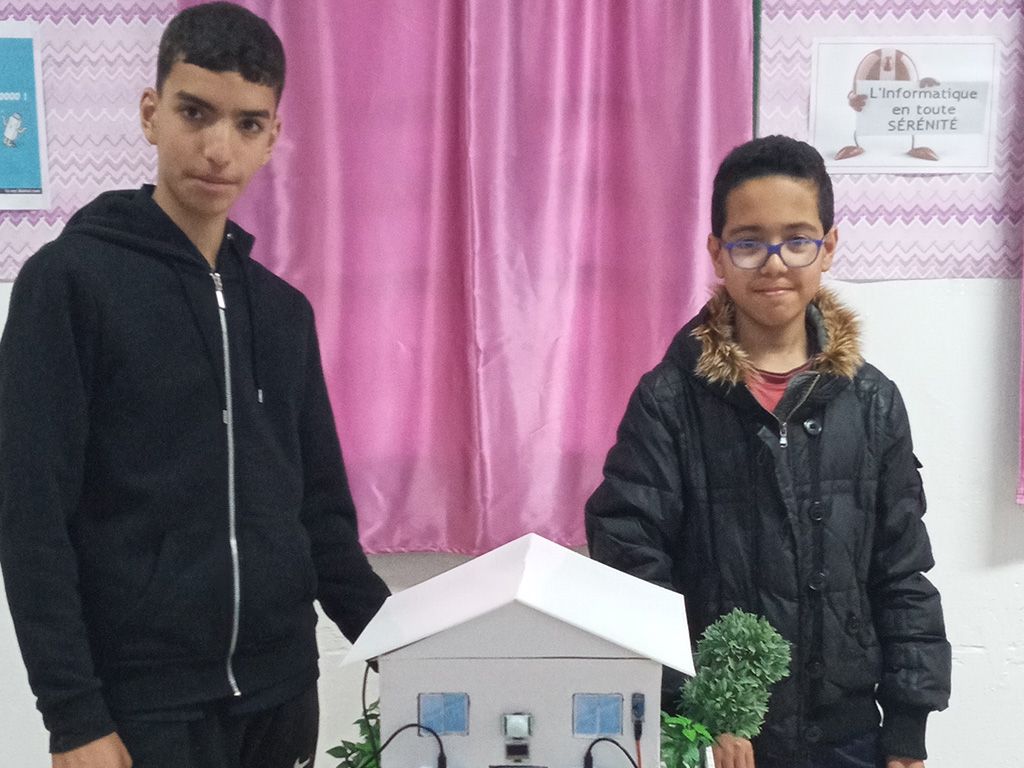
L'équipe présente sa maison intelligente.
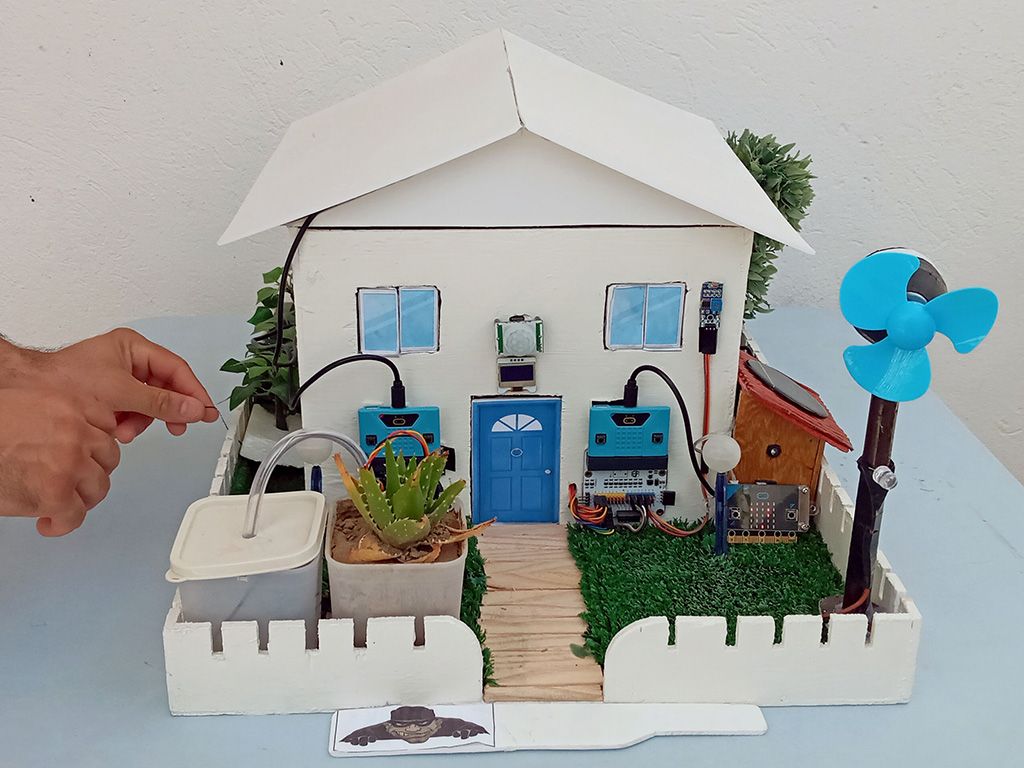
Le prototype maison intelligente
Asie et Pacifique
Malaisie
Jared a inventé « e-mom », un dispositif intelligent pour aider à surveiller et à maintenir une bonne posture et une bonne pratique lors de l'apprentissage en ligne. La « e-mom » dit aux enfants de maintenir une distance raisonnable entre leurs yeux et l'écran de l'ordinateur, surveille l'éclairage ambiant dans la salle d'étude et est équipé d'un minuteur pour rappeler aux enfants d'avoir de courtes pauses et de boire de l'eau !
Jared a déclaré : « J'ai découvert qu'avec un esprit créatif et innovant, je pouvais trouver une solution simple mais pratique ».
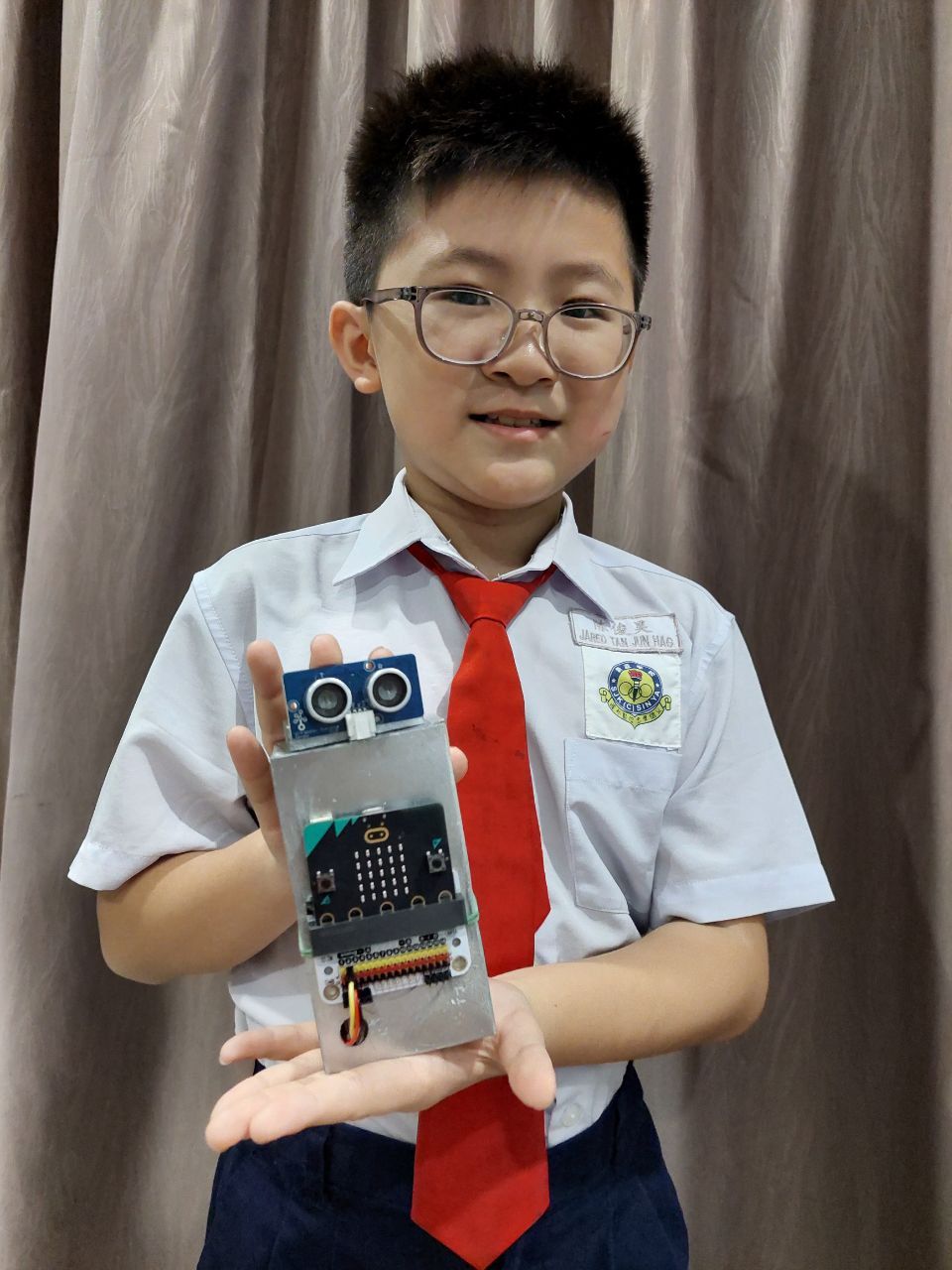
Jared présentant son « e-mom », un appareil intelligent pour aider les élèves.
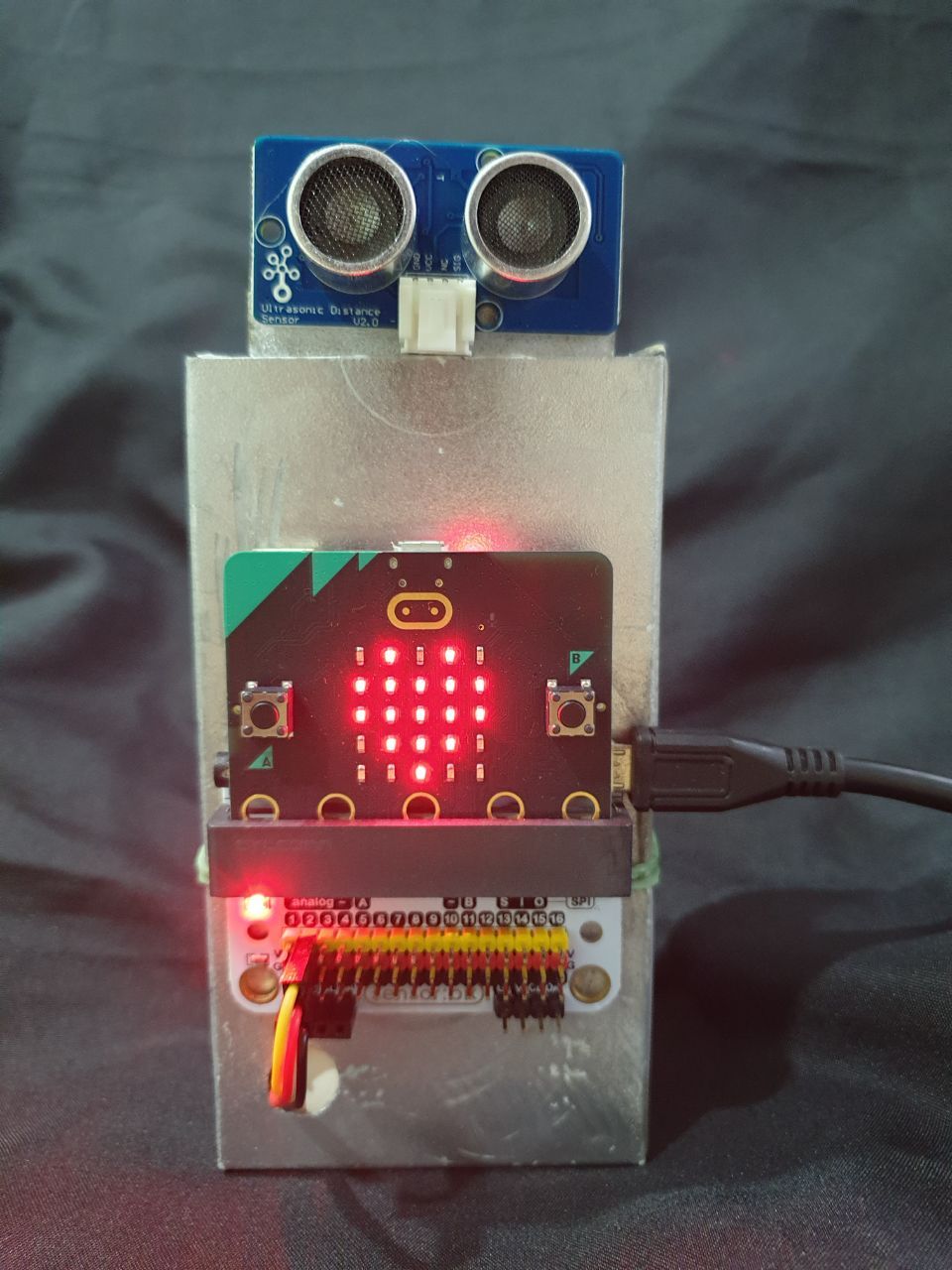
« e-mom » en action
Europe
Bosnie-Herzégovine
La création d'Ahmed est une alarme à détecteur de feu qui aide à éteindre les incendies en utilisant des énergies renouvelables. Un moulin à eau fournit de l'énergie pour commander une micro:bit qui, à son tour, déclenche une pompe à eau si un incendie est détecté par les capteurs.
Ahmed raconte : « J'ai choisi ce projet parce que je sais combien les incendies sont dangereux pour l'environnement, la communauté humaine et surtout pour les animaux. »
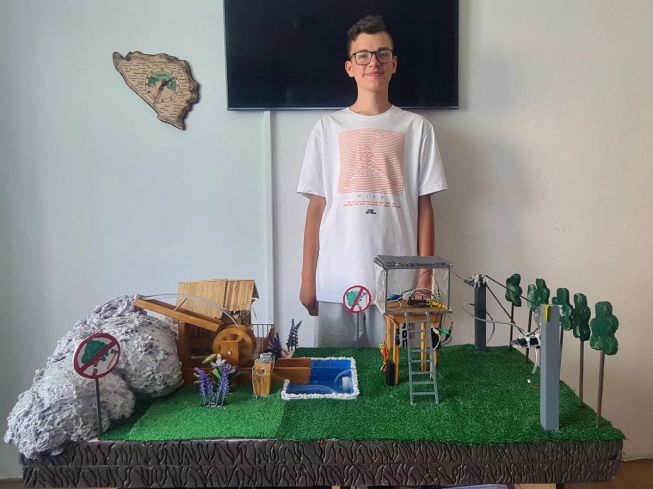
Ahmed avec sa création, l'alarme du capteur de feu.
Amérique latine
Uruguay
Juan était motivé par la création du « système de détection précoce des feux de forêt » après un grand incendie de forêt en Uruguay. Le système utilise des capteurs micro:bit pour surveiller la température et l'humidité et alerter les pompiers si nécessaire. Juan voulait créer l'appareil pour éviter la destruction des écosystèmes.
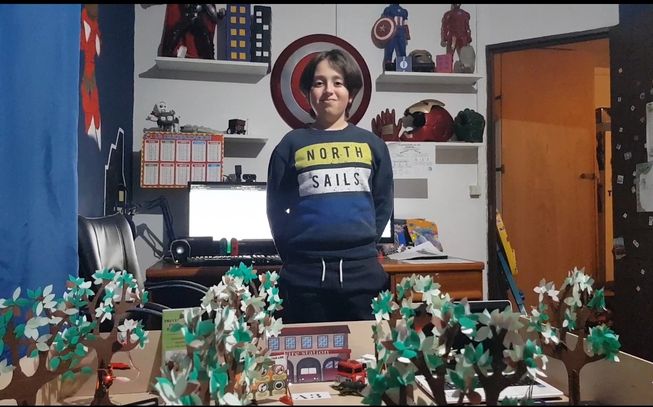
Juan nous montre sa création de détection précoce des incendies.
Moyen-Orient
Arabie Saoudite
La « piste de course générée par électricité » de Zayd transforme l'énergie de la marche ou de la course en électricité. Zayd voulait créer un dispositif qui non seulement nous empêche de brûler des combustibles fossiles, mais encourage également les gens à mener un mode de vie plus sain.
Dans le futur, Zayd aimerait être ingénieur en mécatronique. Il raconte : « Je veux créer plus d'inventions de ce type qui aideraient le monde. »
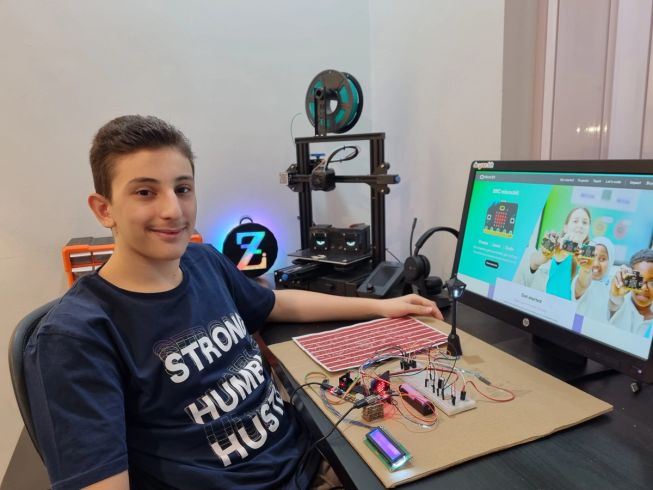
Zayd avec son prototype « piste de course pour l'électricité ».
Amérique du Nord
États-Unis
Le TASC d'Isla (Teacher and Student Communication) permet aux enseignants et aux élèves de communiquer en classe en utilisant la fonction radio micro:bit. Isla souhaitait créer une solution permettant aux élèves timides ou ayant besoin d'une aide supplémentaire d'obtenir un soutien sans être gênés de le demander.
Isla commente : « C'est incroyable d'avoir gagné ce défi au cours de mes premiers mois d'utilisation du micro:bit. »
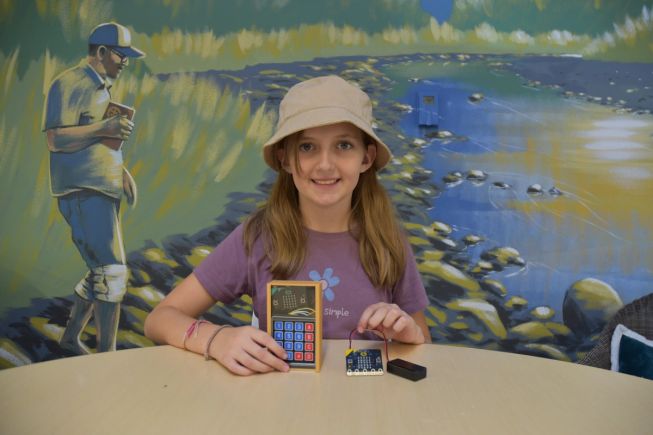
Isla nous montre son dispositif Teacher and Student Communication (TASC).
8-14 ans, prototypes papier
Dans cette catégorie, nous avons demandé aux jeunes de créer un prototype papier pour expliquer leur idée.
Afrique
Tunisie
Oussema a remarqué que le changement climatique peut augmenter le nombre d'accidents d'avalanche dans les régions montagneuses du monde. Son « détecteur AV » détecte les avalanches et avertit les autorités qu'il faut évacuer les villageois qui pourraient être touchés. Il peut également être utilisé pour localiser les randonneurs et les grimpeurs potentiellement en danger.
Oussema déclare : « Nous pouvons toujours contribuer à résoudre les problèmes de tous les jours avec des idées innovantes et des technologies appropriées. »
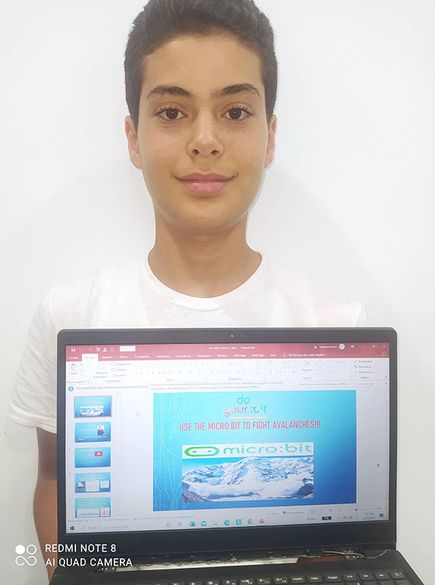
La conception d'Oussema pour son détecteur AV.
Asie et Pacifique
Taïwan
Jing Yan a réfléchi à de nombreux problèmes auxquels sont confrontés les agriculteurs pour la création de son « Smart Farming Helper ». L'appareil utilise de l'eau froide pour arroser et entretenir les terres agricoles et aussi pour se débarrasser des parasites non désirés qui ruinent les cultures. Jing Yan a pensé que son idée aiderait les agriculteurs à développer des méthodes agricoles durables.
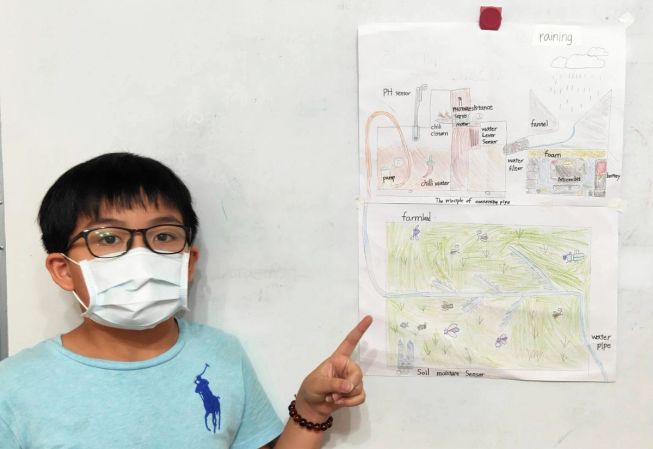
Jing Yan affiche son design « Smart Farming Helper ».
Europe
Royaume-Uni
Molly-Rosanna a créé le « Help A:bit », un appareil portable conçu pour garantir la sécurité des gens dans la rue. C'est un dispositif de sécurité qui se connecte à votre mobile via Bluetooth et qui peut suivre les localisations, appeler les services d'urgence, et avertir les contacts d'urgence en appuyant sur un bouton. Molly-Rosanna a conçu cet appareil pour aider les femmes à se sentir en sécurité et à se protéger lorsqu'elles marchent seules.
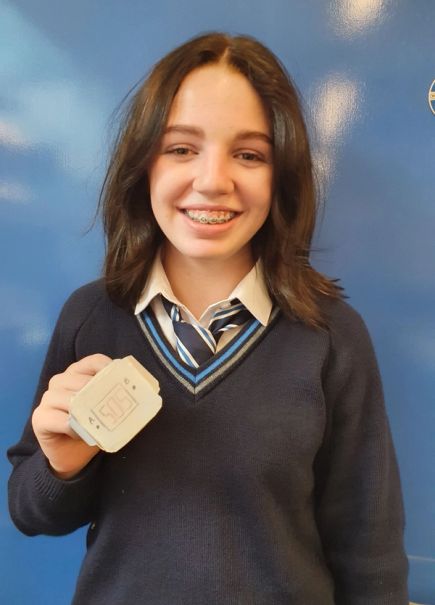
Molly-Rosanna montre un modèle de l'appareil « Help A:bit » qu'elle a créé.
Amérique latine
Brésil
Le projet ACVM de Vinicius et Antonio vise à réduire l’excès de dioxyde de carbone dans l’atmosphère. Il utilise un compteur de CO2 pour détecter la quantité de gaz dans l'air et envoie ces informations au micro:bit pour calculer combien d'arbres et de plantes seront nécessaires pour enlever ce CO2 de l'air.
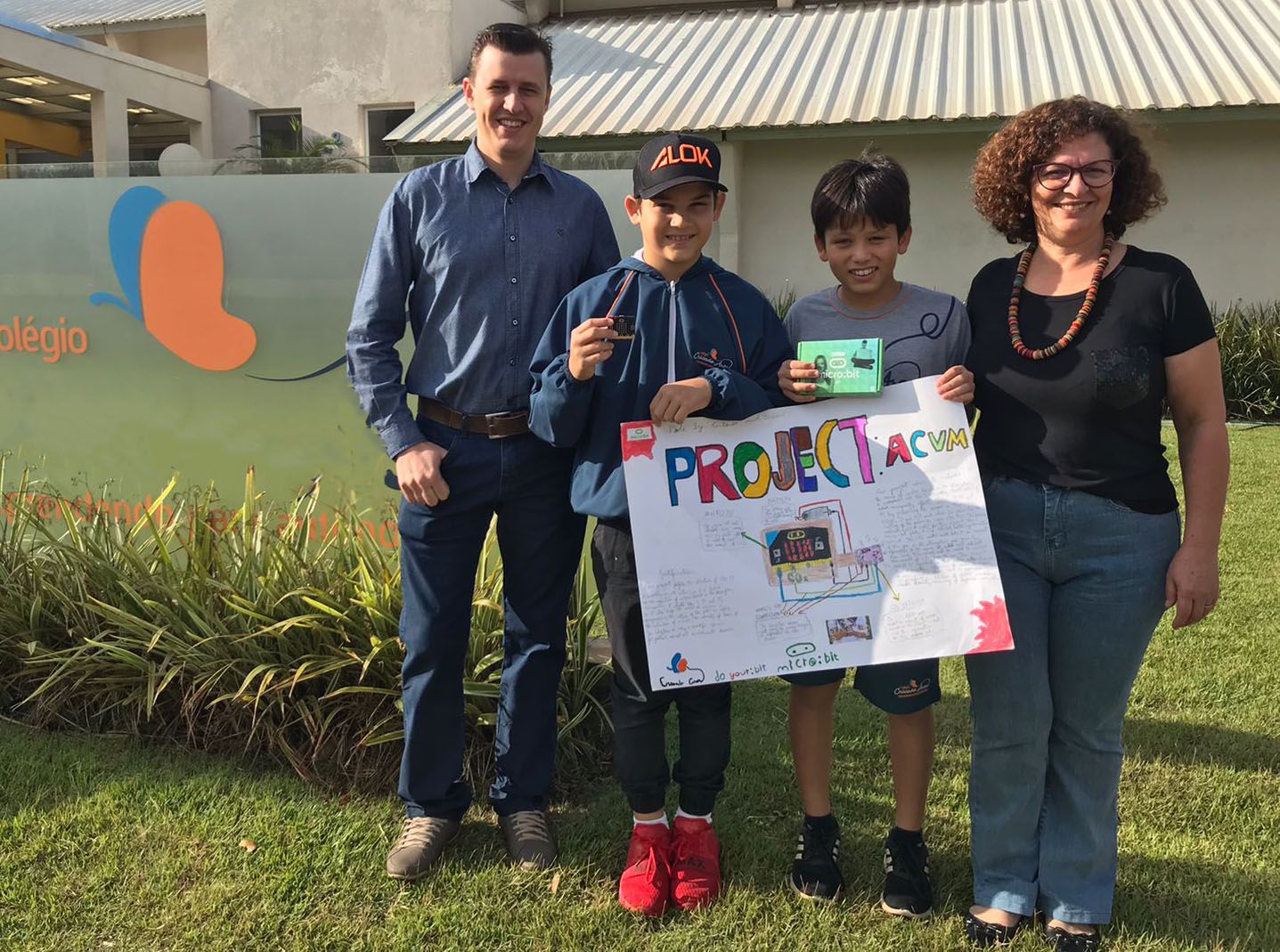
Vinicius, Antonio et leurs professeurs exposent leur travail.
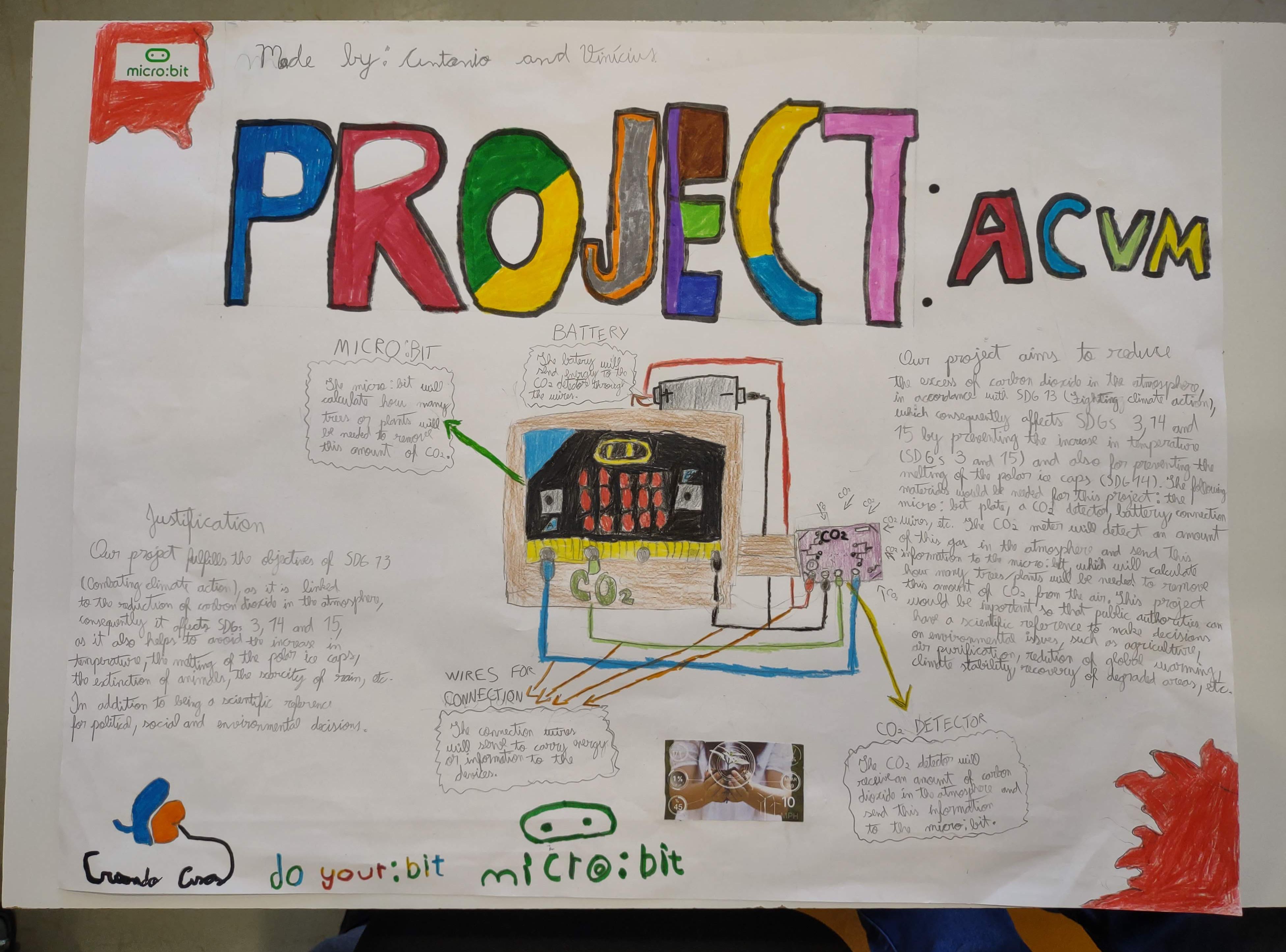
Vinicius et Antonio illustrent leur design micro:bit.
Moyen-Orient
Turquie
Alper a créé le « Deaf:bit », une invention pour aider les personnes malentendantes à vivre de manière autonome.
Il dit : « La famille de mon ami est sourde. J'ai vu le problème qu'ils avaient et je voulais développer un prototype pour eux. Je me suis demandé comment trouver une solution simple. Quand mon professeur a introduit les fonctionnalités du micro:bit V2, j'ai trouvé comment le faire. »
L'appareil est porté en tant que bracelet et utilise plusieurs micro:bits pour donner des avertissements dans diverses situations comme lorsque la cloche de la maison sonne, qu'un bébé pleure ou qu'un klaxon retentit.
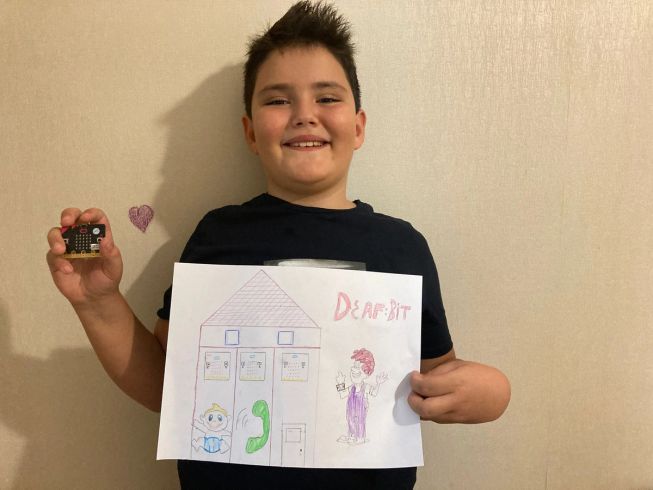
Alper et son design gagnant « Deaf:bit ».
15-18 ans, solution micro:bit
Les jeunes de 15 à 18 ans ont été mis au défi de concevoir et de faire une solution en utilisant le micro:bit.
Afrique
Kenya
Shanice a créé le « Balanced Diet Finder » pour aider sa communauté à planifier des repas équilibrés sains et nutritifs. La solution, développée à l'aide de l'IA et du micro:bit, classe la nourriture en groupes alimentaires et aide l'utilisateur à faire des choix sains.
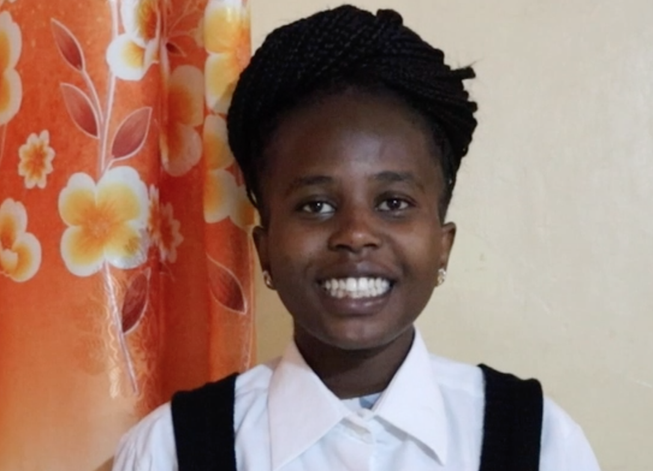
Shanice, vainqueur de do your :bit au Kenya.
Asie et Pacifique
Vietnam
Dang, Nguyen et Bui ont conçu le « Système de soutien aux soins de santé pour les personnes âgées ». Le système comprend des capteurs pour mesurer la santé et l'environnement de l'utilisateur qui sont ensuite accessibles aux médecins ou à la famille. Le système dispose également d'un mécanisme automatique pour dispenser le dosage correct de médicaments au bon moment pour l'utilisateur.
Les élèves parlent de leur création, « Cela créera une forte motivation pour être plus passionné par la technologie et l'informatique et nous encourager à devenir de futurs programmeurs. »
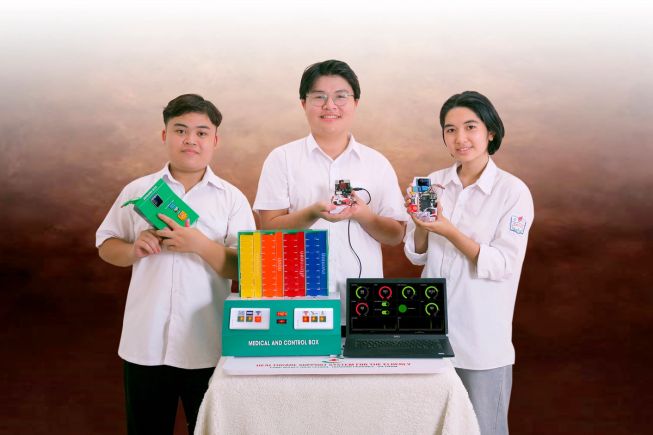
Dang, Nguyen et Bui affichent leur système de soins de santé micro:bit.
Malaisie
Fatin, Wan et Ahmad ont créé « Animal Foresee » pour tenter de réduire le nombre d’animaux tués en traversant la route. Dans leur pays, la Malaisie, ils tentent de protéger les éléphants, mais ils ont noté que cet appareil pouvait être utilisé pour détecter de nombreux types de faunes, y compris les tigres, les élans et les renards. L'appareil utilise l'accéléromètre du micro:bit pour détecter les éléphants près d'une route et la fonctionnalité radio pour alerter les conducteurs.
L'équipe dit « Participer au défi do your :bit nous a incité à rechercher des problèmes dans notre monde et à essayer de trouver un moyen de les résoudre en utilisant la technologie ».
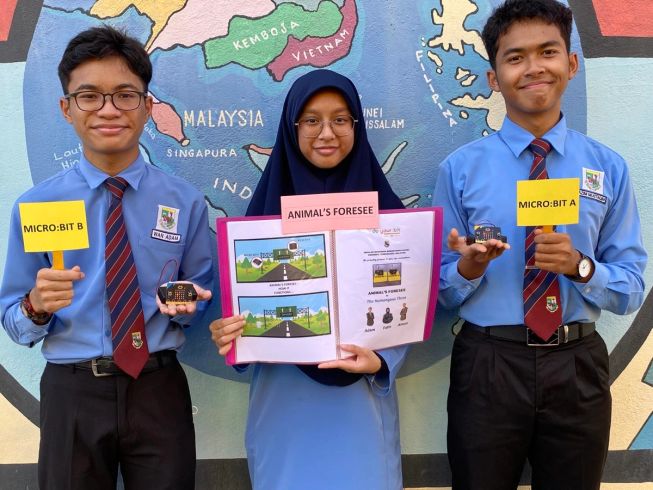
Fatin, Wan et Ahmad présentent leur création « Animal Foresee ».
Europe
Hongrie
Qingzhe a conçu le « Gardien du temps » pour protéger les animaux contre les accidents ferroviaires. L'appareil détecte et chronomètre les trains entrants, et utilise ensuite le son pour chasser les animaux susceptibles d'être en danger.
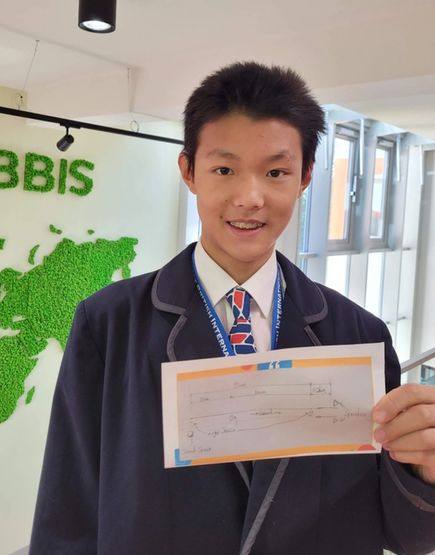
Qingzhe Jacob Zhang présente son design pour la création du « Gardien du temps ».
Amérique latine
Colombie
Le système d’irrigation intelligente de Mario et Daniel vise à utiliser efficacement les ressources, telles que l’eau, les engrais et l’énergie. Il utilise le micro:bit et un capteur d'humidité pour surveiller les conditions et une pompe à eau pour créer un jardin entièrement automatisé. L'équipe a déclaré que leur projet avait pour but « d'utiliser la technologie pour servir la nature et protéger l'environnement ».
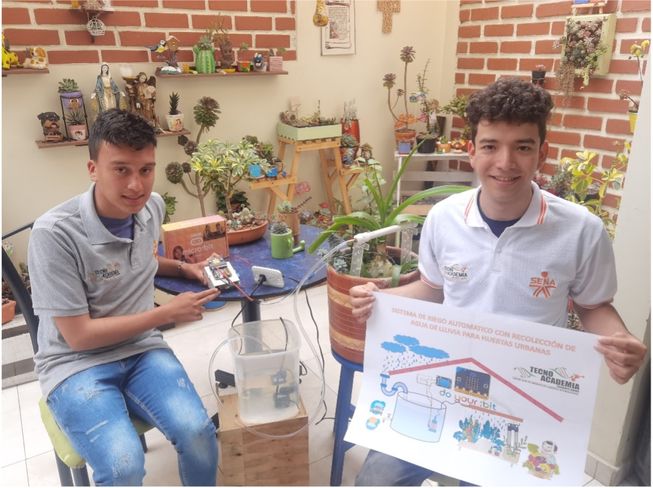
Mario et Daniel avec le design et le prototype du système d’irrigation intelligente.
Moyen-Orient
Liban
Ali a conçu le « Système de surveillance de salle » pour créer des espaces sains pour vivre et se rencontrer. Le système utilise micro:bit pour surveiller les niveaux d'humidité, de température et de fumée dans une pièce. Il avertit les utilisateurs si des mesures sont nécessaires, comme une augmentation de la ventilation, afin de créer un environnement sain.
Ali raconte, à propos du défi do your :bit, « Cette expérience m'a appris à ne jamais abandonner, même si le problème paraît insoluble. »
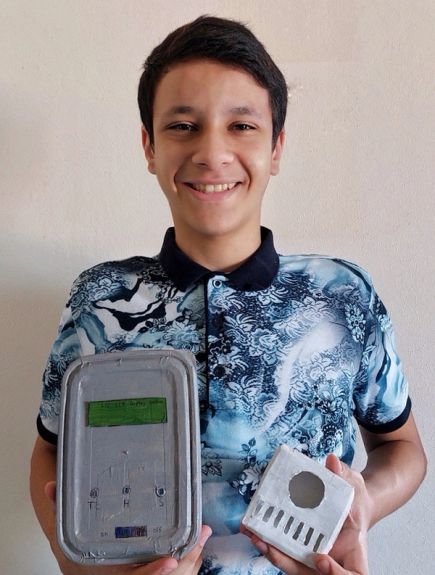
Ali avec son modèle du « Système de surveillance de salle ».
Amérique du Nord
États-Unis
Dawsen et Matson ont créé « L’aide aux incendies pour les lieux à risque » afin de protéger les écosystèmes à risque d’incendies de forêt. Le système est un détecteur de température, détecteur de feu, et dispositif de mesure du sol qui peut être attaché à un arbre ou placé dans le sol pour prévenir les incendies majeurs. La solution utilise les capteurs micro:bit et les LED pour afficher les données de surveillance.
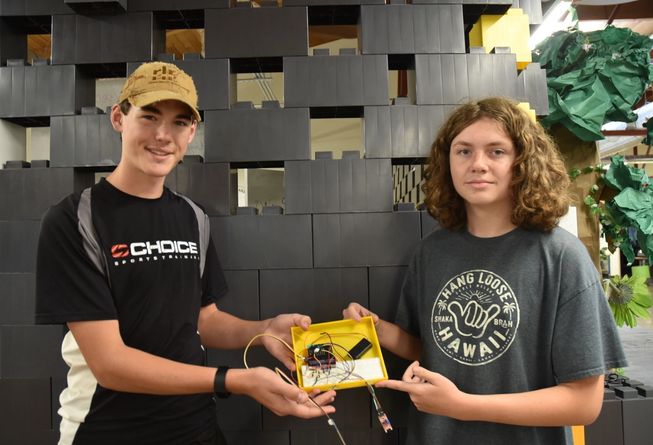
Dawsen et Mason avec leur appareil.
Finalistes
8-14 ans, catégorie solution micro:bit
Afrique
Mariem, Alaa et Mohamed, Tunisie - un incubateur de tortue de mer qui contrôle la température du sable pour aider à protéger les tortues de mer et à déterminer le sexe des nouveau-nés.
Balkis, Tunisie - la « Marionnette intelligente » aide les enseignants à communiquer avec les élèves autistes.
Asie et Pacifique
Yuuka, Akari et Lila, Japon - « Watey » est une application qui aide les familles à économiser de l'eau pendant la douche.
Zi, Chine - un bras bionique pour soutenir les personnes souffrant de handicaps manuels à accomplir des tâches.
Europe
Kriton, Giorgos et Kuriakos, Grèce - un appareil qui détecte si les bouteilles d'eau ont été exposées au soleil trop longtemps, causant potentiellement une contamination de l'eau par les produits chimiques contenus dans la bouteille.
Bozica et Andrej, Macédoine - un bateau qui peut recueillir les déversements toxiques.
Amérique latine
Sara, Sebastian et Mariana, Colombie - projet qui recycle l'huile de cuisson usagée en un combustible renouvelable.
Michelle et Johan, Colombie - un système intelligent de tri et de stockage des déchets.
David, Pérou - la « boîte de respiration hexagonale » enseigne aux gens une technique de respiration qui vise à réduire le stress.
Moyen-Orient
Mustafa, Irak - « Happy Date Palms » aide les fermiers à augmenter la productivité des dattiers qui poussent en Irak.
Cybelle et Joury, Liban - le traqueur de date d'expiration de la nourriture aide à prévenir les déchets alimentaires.
Amérique du Nord
Heritage Engineers, USA - le « Micro Band » est porté par les bûcherons pour les empêcher de couper trop d'arbres et de contribuer à la déforestation.
Olivia et Lucy, États-Unis - Le « Détecteur de surpêche 3000 » pèse la quantité de poissons sur un bateau pour prévenir la surpêche.
8-14 ans, catégorie prototype papier
Afrique
Ahmed, Tunisie - le « bit:care » aide les patients de la maladie d'Alzheimer dans leur vie quotidienne.
Douaa, Rimes et Ikram, Tunisie - un épouvantail robot qui utilise des capteurs pour protéger les cultures et les jardins.
Asie et Pacifique
Eunji et Nakyung, Corée du Sud - un appareil qui surveille et gère la population de chats errants dans les zones résidentielles.
Alessio, Adrian et Ronan - la « Vie verte 7000 », un robot qui plante de nouveaux arbres.
Europe
Ayla et Amelie, Royaume-Uni - le « Help-o-meter » permet aux sans-abri de se faire aider discrètement.
Chloe et Lexie, Royaume-Uni- le « Smiley-bit » envoie des messages positifs via le micro:bit pour soutenir la santé mentale des gens.
Amérique latine
Anahy et Samyra, Brésil - une jauge sonore qui surveille les niveaux de bruit dans les écoles.
15-18 ans, solution micro:bit
Afrique
Mohamed et Iyed, Tunisie - « Temp-reg » permet de régler la bonne température dans un réfrigérateur pour stocker des médicaments.
Taha et Amine, Tunisie - un appareil qui détecte les fuites de gaz et la fumée dans la maison et alerte les familles de tout danger.
Asie et Pacifique
Ain, Nik et Ahmad, Malaisie - un détecteur de mauvaise posture pour encourager les utilisateurs à adopter une bonne posture.
Rio et Chihiro, Japon - un système d'économie d'énergie pour surveiller l'utilisation de la lumière dans une maison familiale.
Amérique latine
Christopher, Pérou - le « Contrôle parental » surveille l'utilisation des écrans par les enfants lorsque leurs parents sont absents.
Moyen-Orient
Husain et Sideka, Irak - un système hydroponique automatisé intelligent créé pour minimiser les interférences humaines
Amérique du Nord
Samantha, Etats-Unis - « Nourriture pour tous » aide les banques alimentaires à surveiller leur stock pour s'assurer qu'elles peuvent toujours distribuer de la nourriture à ceux qui en ont besoin.
Shayyan, Charlotte et Udichi, Canada - « Micro:BITE » aide les utilisateurs à surveiller les dates de péremption sur l'emballage alimentaire pour limiter les déchets alimentaires.
Mentions spéciales
Europe
Les juges ont décerné une mention spéciale à Joel, Ryan et Wajih d'Irlande pour leur projet « Chasseur de climat ». Leur création est un système qui capte le CO2 de l'air et le fournit aux algues et autres plantes marines qui l'utilisent pour la photosynthèse et créer de l'oxygène.
Les juges ont voulu saluer le projet de Joel, Ryan et Wajih et la valeur d’une réflexion différente sur le changement climatique. Les juges ont estimé que l'équipe avait fait preuve d'une réelle créativité dans la recherche et la conception de leur solution et d'une pensée originale pour lutter contre le changement climatique.
Moyen-Orient
Les juges ont également décerné une mention spéciale à Ranim, Hala et Maha du Liban pour leur projet « Microps ». Leur création est destinée à éviter que les cultures ne soient détruites par les ouragans et les tornades.
Les juges voulaient saluer la valeur de la réflexion sur des solutions « originales » pour résoudre des problèmes concrets. Les juges ont estimé que Ranim, Hala et Maha ont fait preuve d’originalité et de créativité dans la manière dont ils ont utilisé le microbit pour développer leur solution.